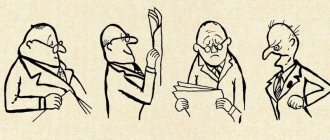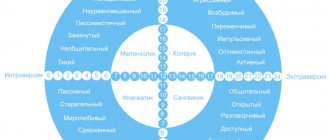History of the test
Eysenck's research in terms of temperament types dates back to the first half of the 20th century. The first questionnaire he compiled appeared in 1947 and was aimed at identifying neuroticism. The questionnaire was compiled by borrowing statements from other tests. You either had to agree with the statements or not.
After this, a second test questionnaire appeared in 1956. It already examined two traits: neuroticism and extraversion/introversion. It also added points to determine the level of sincerity of the subject. The next questionnaire consisted of a larger number of questions, but did not differ in assessment criteria, and only in the last version of the test did another criterion appear - psychoticism, which reveals signs of inadequacy.
Often, during a routine examination using the Eysenck test, they resort to the third form of the questionnaire without assessing psychoticism. To identify temperament, extraversion, neuroticism and the level of sincerity are sufficient.
INTRODUCTION
Ordinary people and professional scientists alike ask many questions related to the concept of “personality.” Ordinary people are interested in questions of the following type: What is a personality conflict? Can people like each other who, from the point of view of personality psychology, are complete opposites? Does it happen that a person’s personality is weakly expressed or absent altogether? For non-professionals, scientific questions are also of interest, among which may be, for example, the following: How much does personality change over time? What factors determine (form, determine) a person’s personality? What are the main personality characteristics? To what extent do personality differences (in and of themselves) influence outcomes such as health status? Why does a person become an introvert or an extrovert, and most often an ambivert?
Thus, the question of the nature of intro- and extroversion is quite relevant now. In our work we will touch upon the definition of these concepts, their nature and personality theories associated with them, as well as some methods with which one can study personality for intro- or extroversion.
So, the goal
Our work is to reveal the concepts of intro- and extroversion and describe the methods of their research.
In accordance with the goal, it is necessary to solve the following tasks:
- analyze the literature on the phenomena under study;
- describe the definitions of the phenomena being studied;
- reveal their specifics;
- describe methods for studying introversion and extroversion.
BIBLIOGRAPHY
- Abramova G.S. Developmental psychology: A textbook for university students. – Ekaterinburg: Business book, 1999.
- Burlachuk L. Psychodiagnostics. – St. Petersburg: Peter, 2002. – 352 p.: ill. – (Series “Textbook of the New Century”). ISBN 5-94723-045-3
- Burlachuk L.F., Morozov S.M. Dictionary-reference book for psychological diagnostics. — Kyiv 1989.
- Godefroy J. What is psychology. In 2 volumes. T.1. – M.: Mir, 1991. – P. 370–377.
- Kon I.S. In search of oneself: personality and its self-awareness. – M., 1984.
- Brief psychological dictionary / Comp. L.A. Karpenko; under general Ed. A.V. Petrovsky, M.G. Yaroshevsky. – M.: Politizdat, 1985.
- Nemov R.S. Psychology. In 3 volumes. T.3. – M., VLADOS, 1999.
- Platonov K.K. A brief dictionary of the system of psychological concepts. - M., 1984.
- Practical psychology in tests, or how to learn to understand yourself and others. – M.: AST-PRESS, 1999. – 376 p.: ill. (“Pedagogy, psychology, medicine”).
- Practical psychology: Textbook / Ed. Doctor of Psychology Sciences, prof., academician BPA M. K. Tutushkina - 4th ed., revised, additional. - St. Petersburg: Publishing house "Didactics Plus", 2001. - 368 p. ISBN 5-89239-014-4
- Rubinshtein S.L. Fundamentals of general psychology - St. Petersburg: Peter, 2000. - P. 177 –225.
- Stolyarenko L.D. Fundamentals of Psychology - Rostov-on-Don: Phoenix, 2000 - pp. 136–164.
- Reader on general psychology. Psychology of thinking / Under. ed. Yu.B. Gippenreiter, V.V. Petukhova. – M.: Moscow State University Publishing House, 1981. – P. 11–152.
Features of Jung's typology
The Swiss psychologist was led to this theory by personal practice and observations of colleagues. Depending on personal characteristics, the psychologist discovered differences in the patients’ behavior and approach to solving problems.
Carl Gustav Jung suggested that mental attitudes predetermine the perception of reality and subsequent reactions. Subsequently, this assumption became the reason for systematizing the typological outlines of his predecessors, which made it possible to determine the differences in thinking. They help to create a personality map that provides guidance in the conscious and controlled functions of the psyche, while revealing hidden archaic ones.
Typology of personalities
From popular psychology we know that extroverts are open and sociable, while introverts are reserved and taciturn. In reality, everything is not so simple. People of the first type are also taciturn, only their psychic energy is directed outward and influences the situation, objects, and people. The actions of introverts are exactly the opposite. When communicating with them, one gets the impression that life depends on the prevailing environmental conditions. They often give in to problems, make excuses or become defensive.
In his book Psychological Types, Jung explains this behavior. The psychologist claims that this depends on the innate adaptive ways of adapting to society, due to the oppressed or protective mechanism of the psyche. Therefore, when interacting with the microworld, introverts protect themselves from the inside, while extroverts are ready for open conflicts. Jung later highlighted:
- 8 types of people based on vertility - the dominant basic function;
- rationality and irrationality;
- identified 4 fundamental properties of the psyche - thinking, feeling, intuition and experience.
Orientation of consciousness
Thinking and feeling refer to meaningful rational perception in accordance with beliefs. People pass information through the filters of consciousness, relying on social laws, but are not always ready to obey the rules of society and act from the mind. Extroverted rationalists are more conservative, diligent, and prefer to plan actions. They do not like to suddenly change plans or communication style.
Irrationals are dominated by sensations and experiences. They think superficially, relying on information from the collective unconscious that enters the mind through associated experiences. People with such mental awareness are called intuitives. They are not characterized by analytical thinking algorithms. Impulsive decisions are made from internal feelings and do not lend themselves to logic, but are always correct
Intuitives do not take into account facts aimed at finding the essence of reality and act on a whim. Learn more about the differences in thinking in the video










